Flinders Street Train Station, a Melbourne icon instantly recognizable by its grand façade and bustling clocks, holds a secret in its upper levels – the Flinders Street Ballroom. Shrouded in myth and rarely seen by the public, this historic space recently opened its doors to host Patricia Piccinini’s captivating exhibition, Miracle Constantly Repeated. This article delves into the ballroom’s rich history, recounts a personal journey of exploration within its walls, and examines the fascinating intersection of art and heritage found within this unique Melbourne landmark.
The Flinders Street Ballroom is one of those whispered-about urban legends, a place everyone seems to know of, yet few have actually experienced. Like fabled secret tunnels beneath city streets, it captures the imagination. Unlike those tunnels, however, the Flinders Street Ballroom is undeniably real, a tangible piece of Melbourne’s vibrant past hidden in plain sight above its busiest train station.
Flinders Street Station itself has been a central transport hub since the 1850s. The station’s current, iconic buildings, showcased in the images below, were the result of an architectural design competition and officially completed in 1910. “Meeting under the clocks” at Flinders Street remains a cherished Melbourne tradition, a testament to the station’s enduring role in the city’s social fabric.
Interestingly, the Ballroom wasn’t part of the original station design. It was added during construction to house the Victorian Railway Institute (VRI). Established in 1910, the VRI aimed to enhance the “intellectual, social and physical well-being” of railway employees. The VRI, which still exists today and has broadened its membership beyond railway workers, originally used the ballroom as a lecture hall. The surrounding rooms were equipped with a gym including a boxing ring, a lending library that delivered books to members via train, and classrooms for evening education. This concept mirrored the Mechanics’ Institutes, which provided educational resources to working-class adults (you can learn more about Mechanics’ Institutes here). The photograph below, courtesy of the State Library of Victoria, shows VRI members in the lecture hall during its early days.
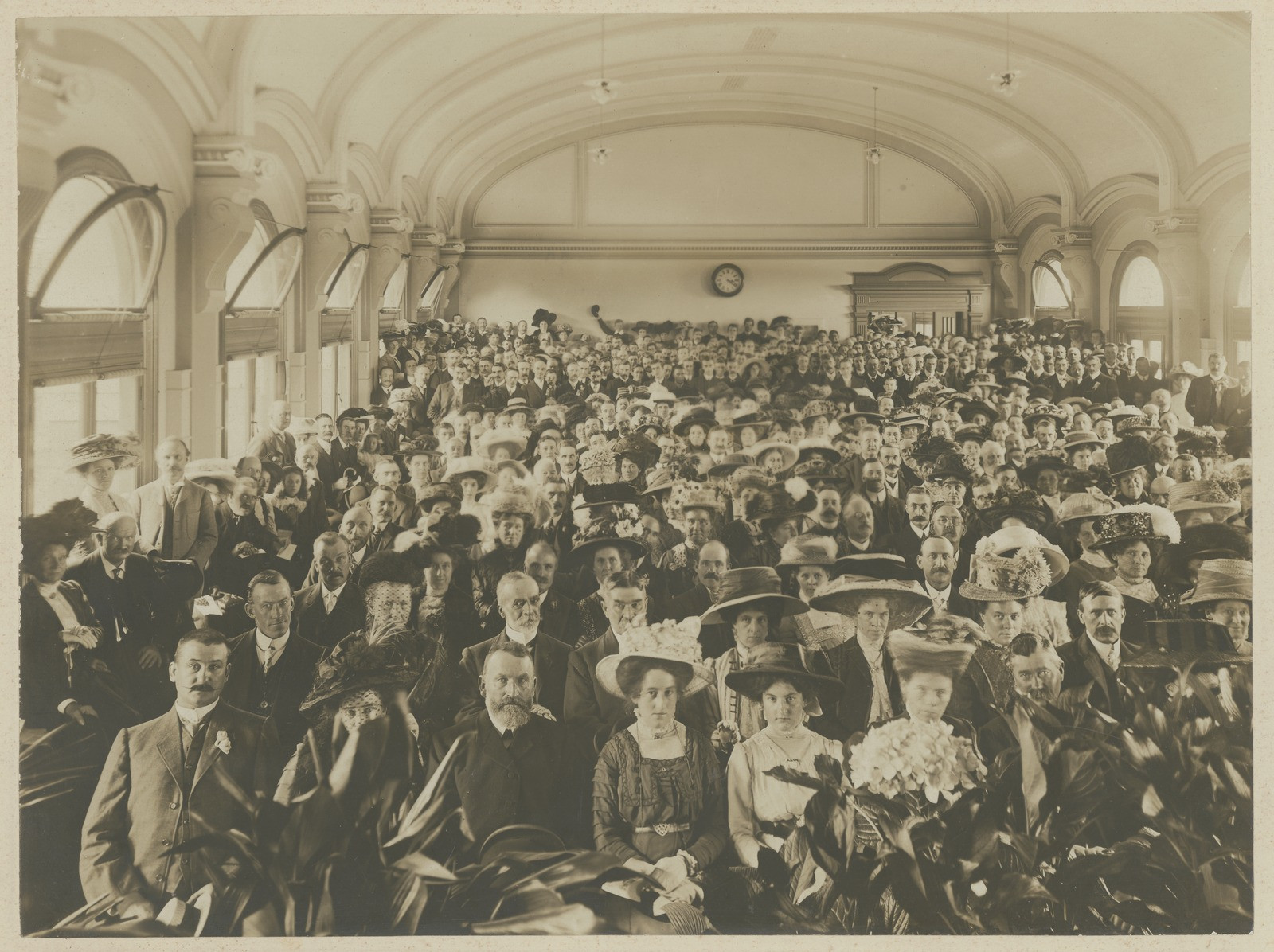 Victorian Railway Institute members in the lecture hall, Flinders Street Station, early 20th century
Victorian Railway Institute members in the lecture hall, Flinders Street Station, early 20th century
Much of the original lecture hall’s structure is still evident within the Ballroom today. Traces of the VRI’s activities can also be seen in the adjacent rooms. However, a message scrawled on a wall, visible in a later photo, is believed to date back to the late 1960s, a time when the upper floors were already showing signs of neglect.
By the 1930s, the lecture hall had transitioned into a ballroom. An image from the Victorian Railways Corporation records, held at PROV, depicts the ballroom adorned with bunting, ready for a lively event.
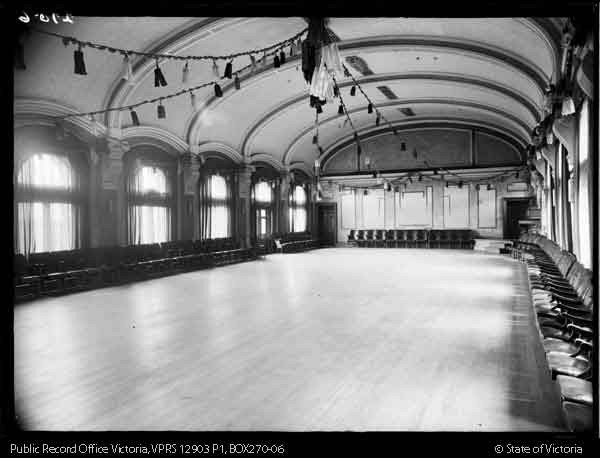 Flinders Street Ballroom decorated with bunting, circa 1930s
Flinders Street Ballroom decorated with bunting, circa 1930s
The ballroom’s popularity soared by the 1950s, with dances so well-attended that a mezzanine level was added to accommodate the crowds. These glamorous balls always concluded by midnight, ensuring attendees could catch the last train home, perfectly integrating the ballroom into the rhythm of Melbourne’s public transport.
However, by the 1970s, the ballroom and surrounding rooms began a period of decline. The final dance was held in 1983, and by 1985, public access to the ballroom and its adjacent spaces was almost entirely restricted. Every decade or so, announcements regarding refurbishment and future plans for the space would surface. Ideas ranged from relocating the Melbourne City Library to the third floor (a proposal favored by some due to the library’s need for space), to reopening the Ballroom as a dance venue once again, or even establishing a school within its walls. Despite numerous concepts, none materialized. In 2015, the Andrews Government initiated a comprehensive restoration of the Flinders Street Station complex, which included the daunting task of removing ten tonnes of pigeon droppings from the station’s dome. The Ballroom is part of this ongoing redevelopment project, but its future purpose remains undecided. A video showcasing the development of the Ballroom and the wider station precinct offers further insight.
While the long-term use of the Ballroom remains uncertain, it has occasionally been accessible to the public, primarily through Open House Melbourne (access to which was via a ballot system) and as a space for artists to create. The recent Rising Festival provided one such opportunity, marking the beginning of my own long-awaited journey into the Flinders Street Ballroom and a shift from historical narrative to artistic exploration.
As mentioned earlier, gaining entry to the Ballroom had been a personal quest for about a decade. It’s precisely the kind of intriguing historical location that ignites my imagination and fuels my desire to explore off-the-beaten-path places – a core motivation behind this blog. Therefore, when Rising Festival announced the Ballroom’s opening, I secured a ticket immediately. However, as was a common occurrence globally, the COVID-19 pandemic resurfaced, forcing Melbourne into a two-week lockdown and effectively cancelling the festival. Yet, a silver lining emerged. Patricia Piccinini’s Miracle Constantly Repeated exhibition was housed within the Ballroom, a space not designated for other purposes, allowing Rising to extend its run. Fortunately, restrictions lifted the day before my scheduled visit. I was among the first to experience Piccinini’s extraordinary installation within the captivating Flinders Street Ballroom and its surrounding rooms. My exploration of both the art and the historic spaces unfolded linearly, and this article aims to recreate that experience. The rooms are imbued with layers of history, evident in the pressed metal details and glimpses into the building’s past that peek through the stripped-back spaces. I hope this account proves interesting and offers a taste of the almost transcendental experience of encountering Piccinini’s art within the palpable historical atmosphere of the Ballroom.
My exploration began at the unassuming entrance to the staircase leading upwards.
 Entrance door to the Flinders Street Ballroom stairs
Entrance door to the Flinders Street Ballroom stairs
Ascending the three stories, I had little concrete expectation of what awaited me. Even the stairwell itself hinted at the building’s complex and layered history.
Reaching the top, I emerged into a corridor that stretched seemingly into the distance.
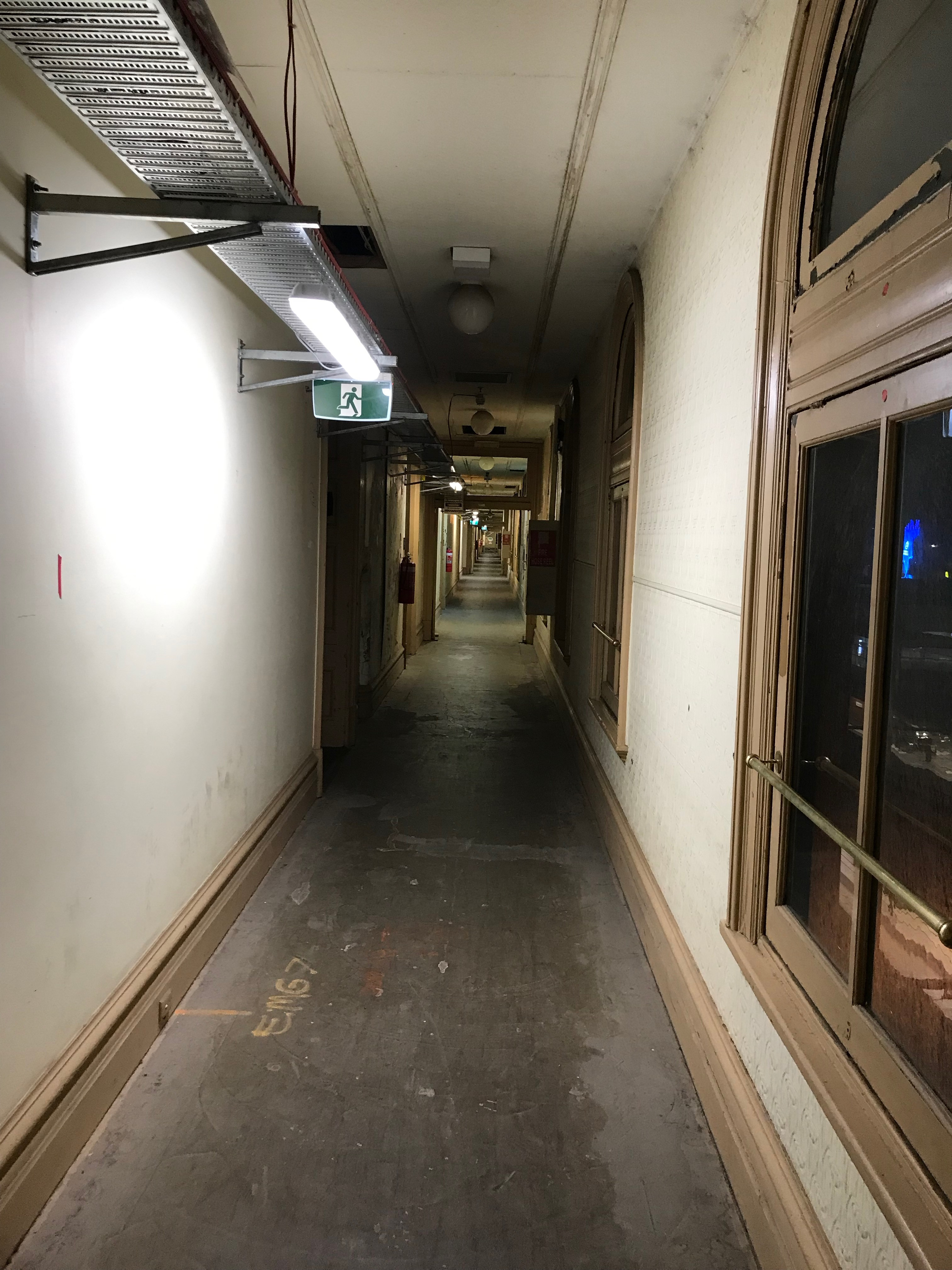 Long corridor leading to the Flinders Street Ballroom
Long corridor leading to the Flinders Street Ballroom
Piccinini’s installations were situated in rooms along this corridor in both directions, culminating in the main installation within the Ballroom itself – an experience truly beyond description and best witnessed firsthand.
As I wandered through the exhibition, immersed in the wonder of Piccinini’s creations, I was simultaneously exploring the building itself, discovering small details revealing layers of time and past renovations. I was also seeing Melbourne from a unique vantage point, a perspective rarely afforded to the public.
The Ballroom also features an abundance of beautiful pressed metalwork on walls and ceilings. My fascination with these details might have become slightly excessive, so rather than scattering these observations throughout the narrative, I’ve compiled an overview of these decorative elements.
Piccinini’s art explores the relationship between nature and the urban environment, the merging of the artificial and the organic. Her works feature objects taking on natural characteristics, nature adapting to mechanization, and chimeric beings inhabiting both worlds, prompting reflection on humanity’s place within this evolving landscape. However, her work extends beyond this, emphasizing kindness and care for both humanity and the environment, and contemplating themes of evolution and change. She creates intriguing creatures that challenge our self-perception and constructs forests of floral, organ-like forms that narrate stories of the past and future, rituals and ecology. Her exhibition description includes a particularly memorable line: “big sculptures don’t just have to be about important men in hats on horseback.”
This is an exhibition that demands in-person viewing to be fully appreciated, particularly in how Piccinini’s work interacts with the Ballroom space. My interpretation, influenced by provided guides, may differ from others’ experiences. The beauty of art lies in this subjective engagement. We encounter an artist’s expression, but the artwork becomes personalized as we interpret it through our own beliefs and understanding of the world. I will share some glimpses of the installation, but strongly encourage experiencing it firsthand if possible.
The exhibition journey begins with Diorama, an artwork referencing historical display methods, blurring the lines between realism and artifice.
Moving onward, Sapling explores the concept of a tree’s sentience and personhood.
 Patricia Piccinini's Sapling installation
Patricia Piccinini's Sapling installation Patricia Piccinini's Sapling installation detail
Patricia Piccinini's Sapling installation detail
In the same room as Sapling, Shoeforms embodies Piccinini’s concept of naturalized technology.
Further along the corridor, The Couple is situated, inspired by Mary Shelley’s Frankenstein. It explores the hypothetical scenario of Frankenstein loving his creation, serving as a meditation on empathy and care. I particularly appreciated how Piccinini designed the entire room around The Couple, creating a lived-in atmosphere that harmonized with the building’s aged aesthetic.
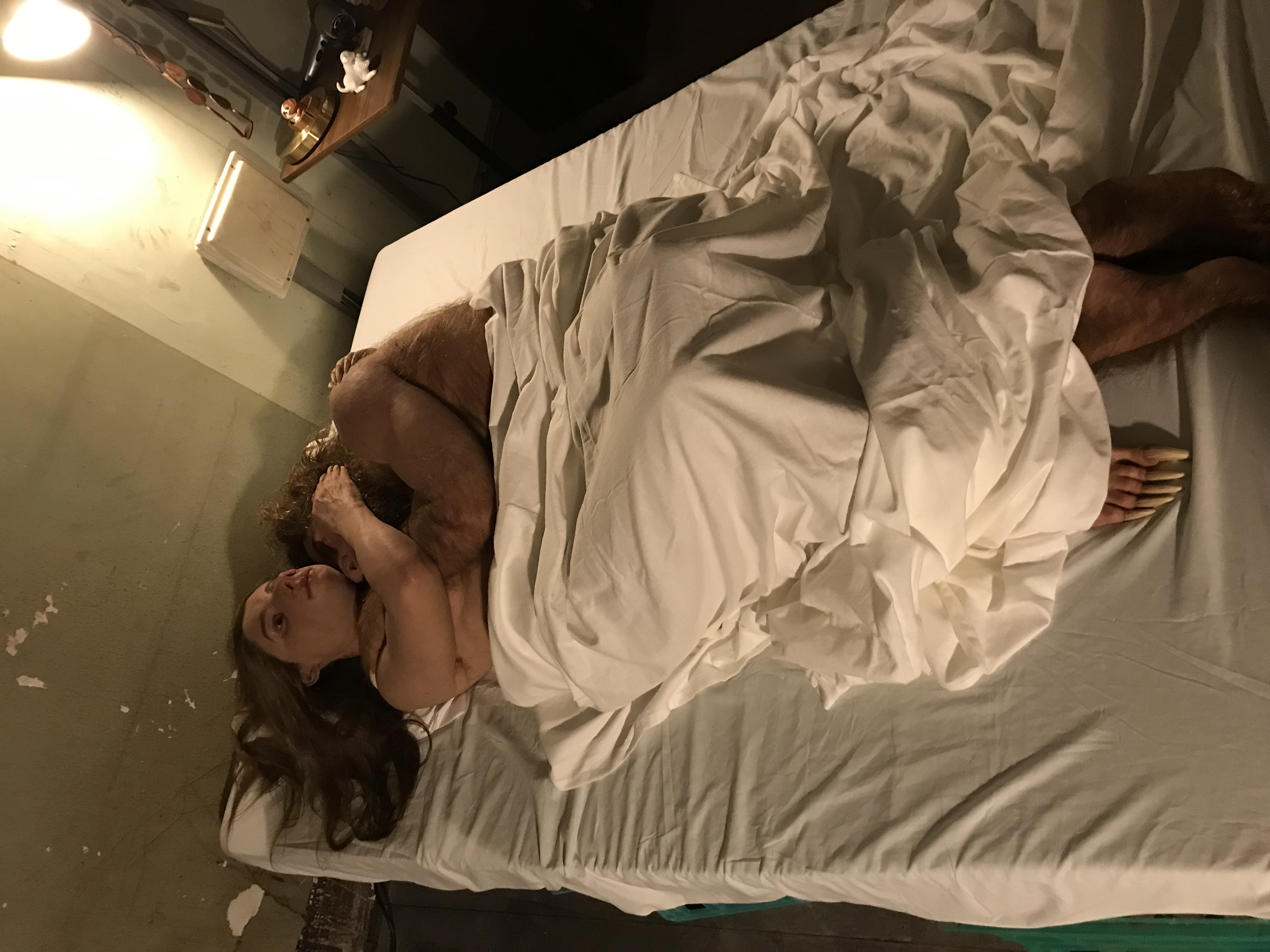 Patricia Piccinini's The Couple installation
Patricia Piccinini's The Couple installation Patricia Piccinini's The Couple installation detail
Patricia Piccinini's The Couple installation detail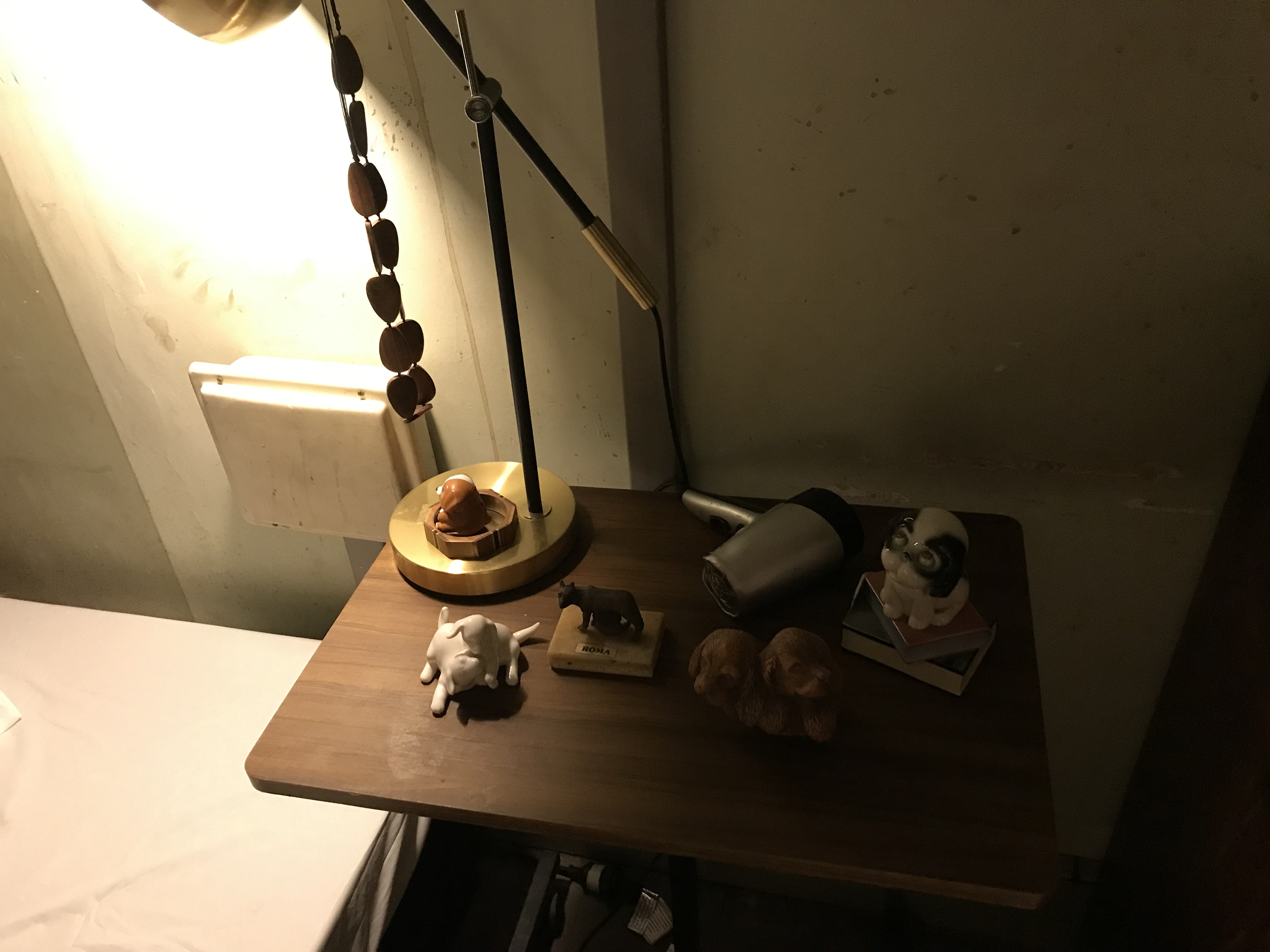 Patricia Piccinini's The Couple installation setting
Patricia Piccinini's The Couple installation setting
The subsequent room, aside from the Ballroom itself, was my personal favorite. Celestial Field is mesmerizing. The boundaries between human and nature dissolve as flower-like, organ-resembling forms grow and hang from the ceiling. In the center, The Balance represents the naturalization of mechanization, with two mechanical forms reaching towards each other.
A short video I captured aims to convey the atmosphere Piccinini masterfully creates.
Next is No Fear of Depths, the previously mentioned large-scale sculpture embodying care.
Following this, perhaps my favorite individual piece by Piccinini, The Supporter, depicts the idea of a natural environment emerging from an urban setting, a symbiotic relationship where humans, nature, and the urban world sustain each other.
Finally, the journey culminates in the Ballroom itself. Words are inadequate to describe it; the images speak for themselves.
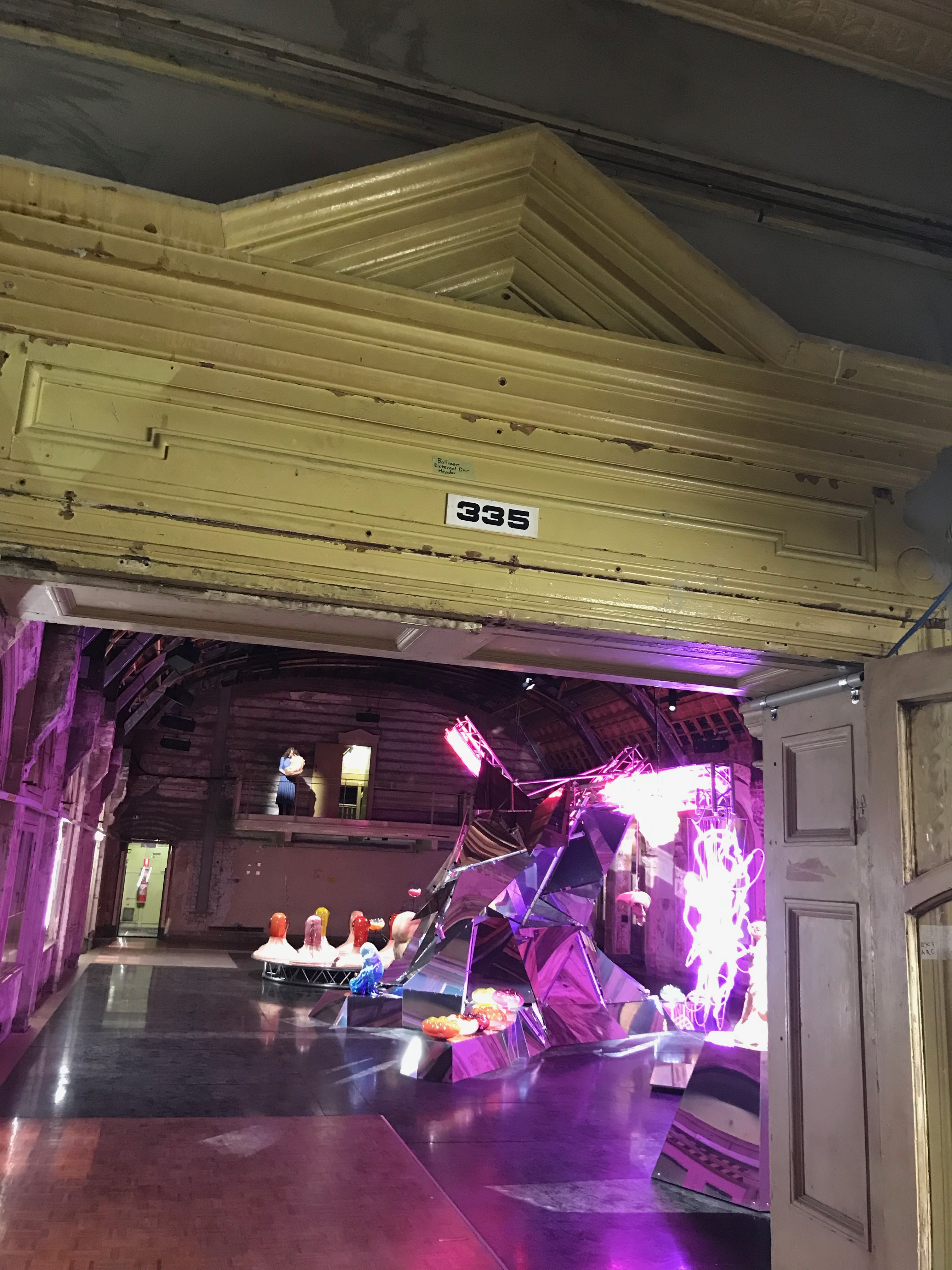 Patricia Piccinini's Ballroom installation, Miracle Constantly Repeated
Patricia Piccinini's Ballroom installation, Miracle Constantly Repeated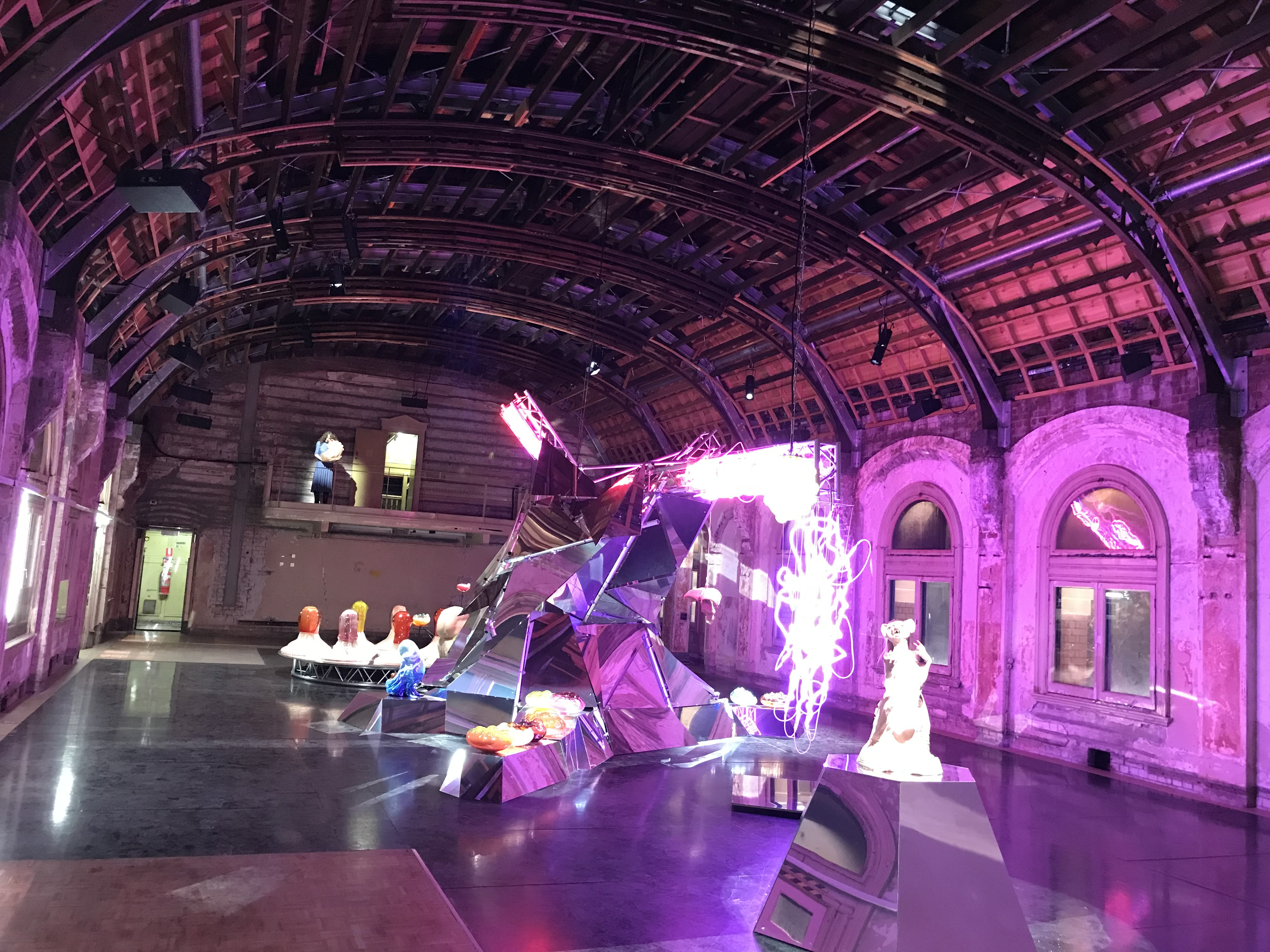 Patricia Piccinini's Ballroom installation, Miracle Constantly Repeated, detail
Patricia Piccinini's Ballroom installation, Miracle Constantly Repeated, detail
As truly miraculous as Piccinini’s A Miracle Constantly Repeated is, the smaller details of the building that resonate with her work – the visible “bones” of the structure, the subtle narratives they whisper – are equally significant to me, aligning with the essence of this blog. I wanted to conclude with these details.
 Wall detail in Flinders Street Ballroom, showing layers of history
Wall detail in Flinders Street Ballroom, showing layers of history
References:
- https://architectureau.com/articles/flinders-street-station-ballroom/?utm_source=ArchitectureAU&utm_campaign=3c0d1a89f2-AAU_2014_02_11&utm_medium=email&utm_term=0_e3604e2a4a-3c0d1a89f2-39753498#
- http://vhd.heritage.vic.gov.au/places/result_detail/752
- https://www.vri.org.au/about
- https://www.atlasobscura.com/places/flinders-street-station-ballroom
- https://www.flindersstreetstation.com.au/third-floor.php
- http://wiki.prov.vic.gov.au/index.php/File:12903-P0001-000364-085.jpg#filelinks
- https://www.development.vic.gov.au/projects/flinders-street-station?page=overview
- http://search.slv.vic.gov.au/permalink/f/cjahgv/SLV_VOYAGER1795533
- https://miracle.rising.melbourne/the-ideas-behind-a-miracle-constantly-repeated
- https://rising.melbourne/festival-program/patricia-piccinini

